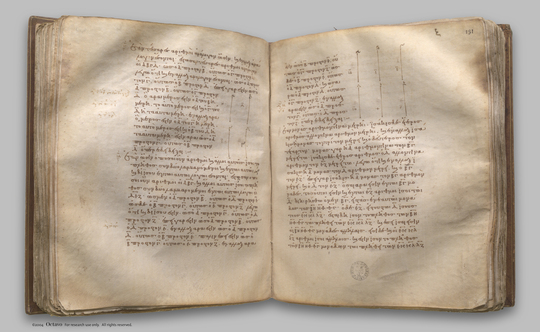index prev next | digilib folio 135

If an unit measure any number, and another number measure any other number the same number of times, alternately also, the unit will measure the third number the same number of times that the second measures the fourth.
| Ἐὰν μονὰς ἀριθμόν τινα μετρῇ, ἰσάκις δὲ ἕτερος ἀριθμὸς ἄλλον τινὰ ἀριθμὸν μετρῇ, καὶ ἐναλλὰξ ἰσάκις ἡ μονὰς τὸν τρίτον ἀριθμὸν μετρήσει καὶ ὁ δεύτερος τὸν τέταρτον. Μονὰς γὰρ ἡ Α ἀριθμόν τινα τὸν ΒΓ μετρείτω, ἰσάκις δὲ ἕτερος ἀριθμὸς ὁ Δ ἄλλον τινὰ ἀριθμὸν τὸν ΕΖ μετρείτω: λέγω, ὅτι καὶ ἐναλλὰξ ἰσάκις ἡ Α μονὰς τὸν Δ ἀριθμὸν μετρεῖ καὶ ὁ ΒΓ τὸν ΕΖ. Ἐπεὶ γὰρ ἰσάκις ἡ Α μονὰς τὸν ΒΓ ἀριθμὸν μετρεῖ καὶ ὁ Δ τὸν ΕΖ, ὅσαι ἄρα εἰσὶν ἐν τῷ ΒΓ μονάδες, τοσοῦτοί εἰσι καὶ ἐν τῷ ΕΖ ἀριθμοὶ ἴσοι τῷ Δ. διῃρήσθω ὁ μὲν ΒΓ εἰς τὰς ἐν ἑαυτῷ μονάδας τὰς ΒΗ, ΗΘ, ΘΓ, ὁ δὲ ΕΖ εἰς τοὺς τῷ Δ ἴσους τοὺς ΕΚ, ΚΛ, ΛΖ. ἔσται δὴ ἴσον τὸ πλῆθος τῶν ΒΗ, ΗΘ, ΘΓ τῷ πλήθει τῶν ΕΚ, ΚΛ, ΛΖ. καὶ ἐπεὶ ἴσαι εἰσὶν αἱ ΒΗ, ΗΘ, ΘΓ μονάδες ἀλλήλαις, εἰσὶ δὲ καὶ οἱ ΕΚ, ΚΛ, ΛΖ ἀριθμοὶ ἴσοι ἀλλήλοις, καί ἐστιν ἴσον τὸ πλῆθος τῶν ΒΗ, ΗΘ, ΘΓ μονάδων τῷ πλήθει τῶν ΕΚ, ΚΛ, ΛΖ ἀριθμῶν, ἔσται ἄρα ὡς ἡ ΒΗ μονὰς πρὸς τὸν ΕΚ ἀριθμόν, οὕτως ἡ ΗΘ μονὰς πρὸς τὸν ΚΛ ἀριθμὸν καὶ ἡ ΘΓ μονὰς πρὸς τὸν ΛΖ ἀριθμόν. ἔσται ἄρα καὶ ὡς εἷς τῶν ἡγουμένων πρὸς ἕνα τῶν ἑπομένων, οὕτως ἅπαντες οἱ ἡγούμενοι πρὸς ἅπαντας τοὺς ἑπομένους: ἔστιν ἄρα ὡς ἡ ΒΗ μονὰς πρὸς τὸν ΕΚ ἀριθμόν, οὕτως ὁ ΒΓ πρὸς τὸν ΕΖ. ἴση δὲ ἡ ΒΗ μονὰς τῇ Α μονάδι, ὁ δὲ ΕΚ ἀριθμὸς τῷ Δ ἀριθμῷ. ἔστιν ἄρα ὡς ἡ Α μονὰς πρὸς τὸν Δ ἀριθμόν, οὕτως ὁ ΒΓ πρὸς τὸν ΕΖ. ἰσάκις ἄρα ἡ Α μονὰς τὸν Δ ἀριθμὸν μετρεῖ καὶ ὁ ΒΓ τὸν ΕΖ: ὅπερ ἔδει δεῖξαι. | If an unit measure any number, and another number measure any other number the same number of times, alternately also, the unit will measure the third number the same number of times that the second measures the fourth. For let the unit A measure any number BC, and let another number D measure any other number EF the same number of times; I say that, alternately also, the unit A measures the number D the same number of times that BC measures EF. For, since the unit A measures the number BC the same number of times that D measures EF, therefore, as many units as there are in BC, so many numbers equal to D are there in EF also. Let BC be divided into the units in it, BG, GH, HC, and EF into the numbers EK, KL, LF equal to D. Thus the multitude of BG, GH, HC will be equal to the multitude of EK, KL, LF. And, since the units BG, GH, HC are equal to one another, and the numbers EK, KL, LF are also equal to one another, while the multitude of the units BG, GH, HC is equal to the multitude of the numbers EK, KL, LF, therefore, as the unit BG is to the number EK, so will the unit GH be to the number KL, and the unit HC to the number LF. Therefore also, as one of the antecedents is to one of the consequents, so will all the antecedents be to all the consequents; [VII. 12] therefore, as the unit BG is to the number EK, so is BC to EF. But the unit BG is equal to the unit A, and the number EK to the number D. Therefore, as the unit A is to the number D, so is BC to EF. |